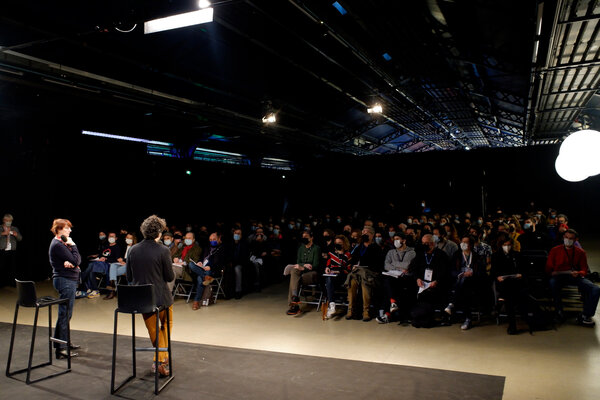Sound is always ahead of the picture!
Dear friends,
Thank you for your screening of lens comparisons, whose interest surpasses the simple visual possibility of making choices in function of aesthetic criteria. The reactions in the theater bore witness to this.
Somewhat superficially, one might conclude that we have moved from the age of “objectifs” [French word for “lens”] objects under observation through a lens – an optical system consisting of a glass lens or a microscope… directed at the object under observation – (a noun that I like to replace by the definition of its adjectival form given by Descartes: “That which consists of a concept, a representation of the mind, and not a formal reality”), to the age of “lenses” [in English in the original], which reduces the object and its function to the part of it consisting in an optical lens.
One might imagine that the specifications drawn up by the R&D engineers of the manufacturers of these lenses consists in making them more and more transparent, achromatic, free of aberrations, in a word: neutral. What we saw with “Full Frames” is proof of the above and if their design philosophy lasts, their tendency towards uniformization will continue to grow.

Sound is often ahead of the picture, and as I exited the screening room, I compared what I’d seen with what has happened in sound recording and postproduction over the past twenty years: the permanent quest for a sort of perfection by smoothing out artistic choices, rough edges and accidents, which results in a technical and artistic uniformization of film soundtracks.
When sound recording of actors’ lines could only be done with microphones that were restricted by the camera frame, you could hear the choice of microphone in the final cut: you could tell who was working with “160”s* and who preferred “415”s**, and then Neumann or Schoeps microphones, which were also highly identifiable.
Highly trained ears could recognize the particular sound of a given sound engineer and could identify the handiwork of certain mixers.
I am not arguing that everything is equally valid today, but the omnipresence of HFs, the less incisive and precise mike pole work, which often settles for leaving more room to the HFs or to extras when shooting with more than one camera, the leveling off of the acoustics and the disappearance of audible takes, combined with an increasingly powerful postproduction process, which really cleans up the sound, have, in my opinion, sanitized direct sound recording to the point that it now is flavorless and reduced to the role of a vector of the lines. A sort of audible subtitling.
With the shift from analogue to digital, with technological choices that are sometimes more guided by economics than aesthetics, the disappearance of mixing tables made by different manufacturers giving way to the current monopoly of a single manufacturer, the addition of a number of “plugins” that are identical in all studios across the globe, are each a little stone that, when added together, creates a sort of perfectly clean sound, which is as insipid as wine made for the export market.
If one adds the issue of compression, it can even become almost inaudible, which is wholly unacceptable! (For those who are interested, see: 19e Semaine du son)
I have experienced these technological mutations and I have asked myself questions regarding the constantly shrinking number of choices I am able to make on set, which has caused me to cease being a sound artisan (I have never liked the term “sound engineer”) and to become what is demanded by producers, namely a “sound recordist”: record, record everything, choose nothing, and delegate it all to postproduction. That’s, in part, what caused me to stop practicing this profession.
Perfect lenses, ever bigger and more defined sensors that let you crop the image, the formidable possibilities of intervention available to colorists, are each a little stone that can transform the cinematographer into an “image recordist”. You still have the creation aspect of lighting with physical light sources. But be careful that you are not overtaken by the virtual sources available in the growing market for 3D: they may dispossess you of this creative process, too.
That is why it is important to fight, as you and others are doing, not in order to say that it was better before, which is a reactionary absurdity, but to keep in mind that creating an image and sound must not only be a process aiming at aseptic and standardized technical perfection (towards which all of these new tools are bringing us), but rather the result of an artistic process that also includes, and perhaps most significantly does include, imperfections, blemishes, brushstrokes, off notes, distortions, texture, accidents… in short, life.
Bravo again and good luck!
Eric Vaucher
* M160 Mike: dynamic ribbon mike by Beyer
** MKH 415 Mike: mike combining a pressure gradient transductor and an interference tube by Sennheiser.
Translated from French by A. Baron-Raiffe.
The thumbnail image above is a cropped still from the Large Format lens tests.
 En
En
 Fr
Fr








